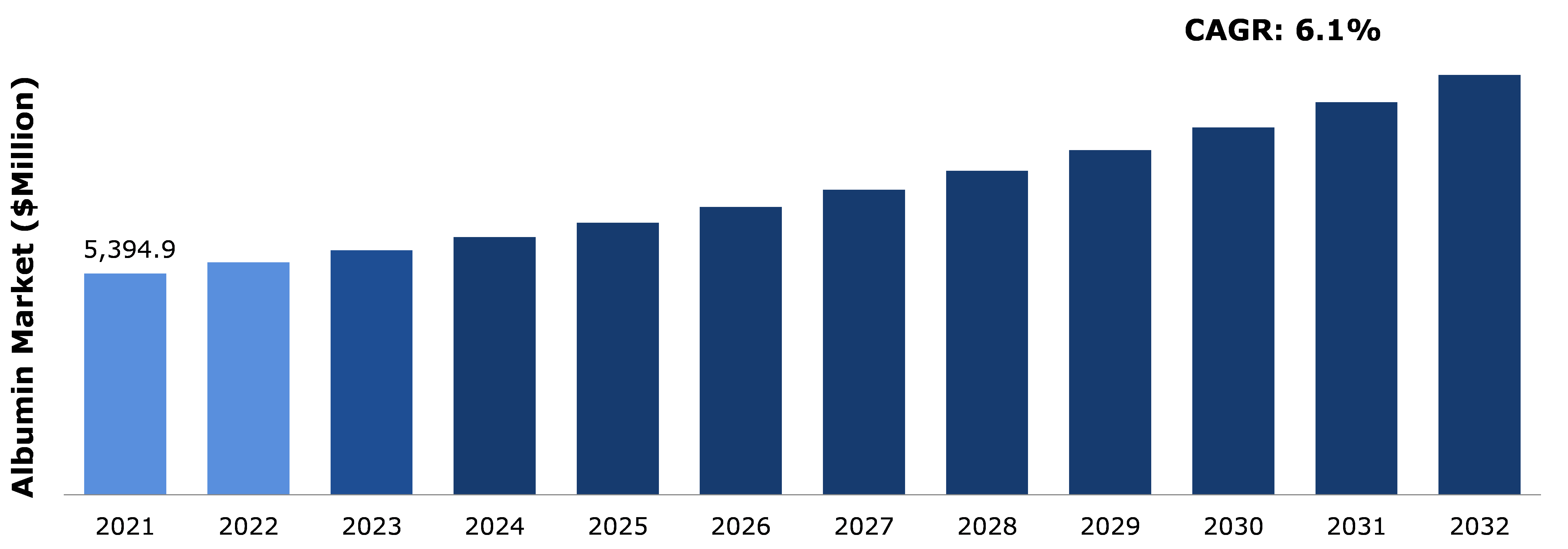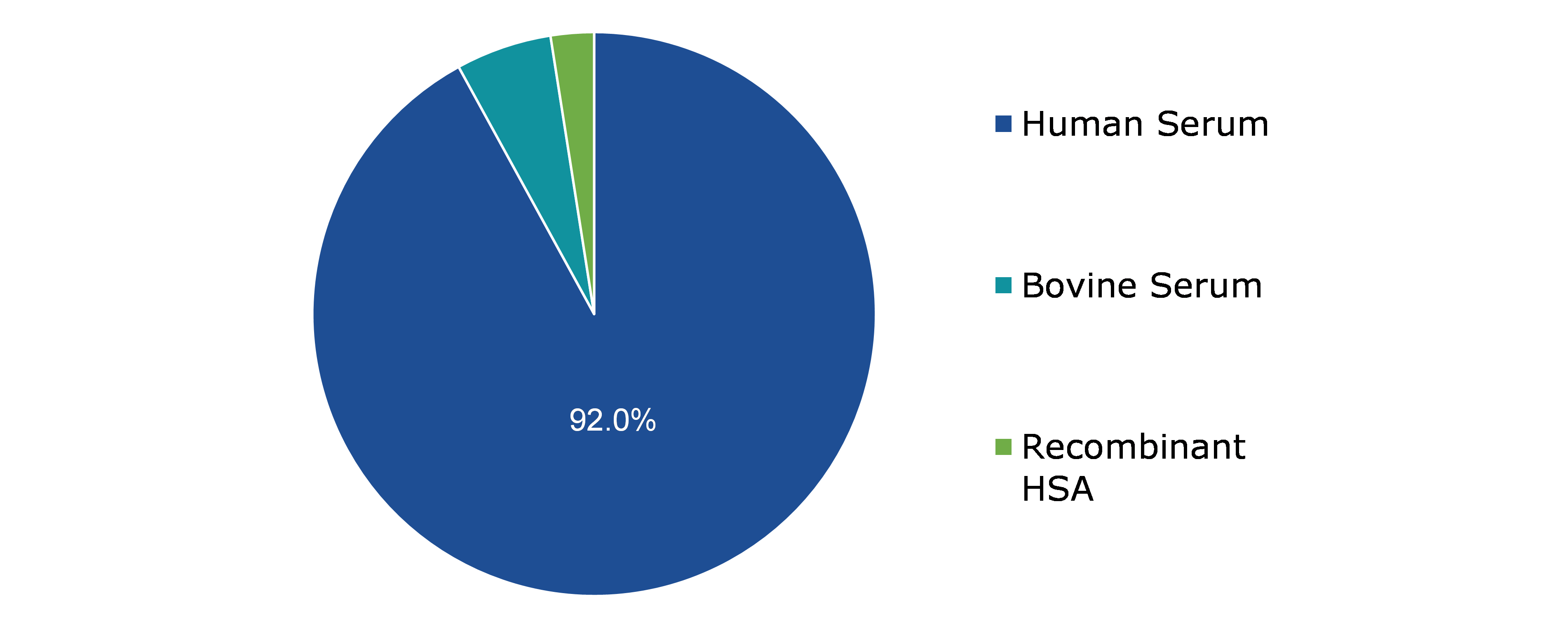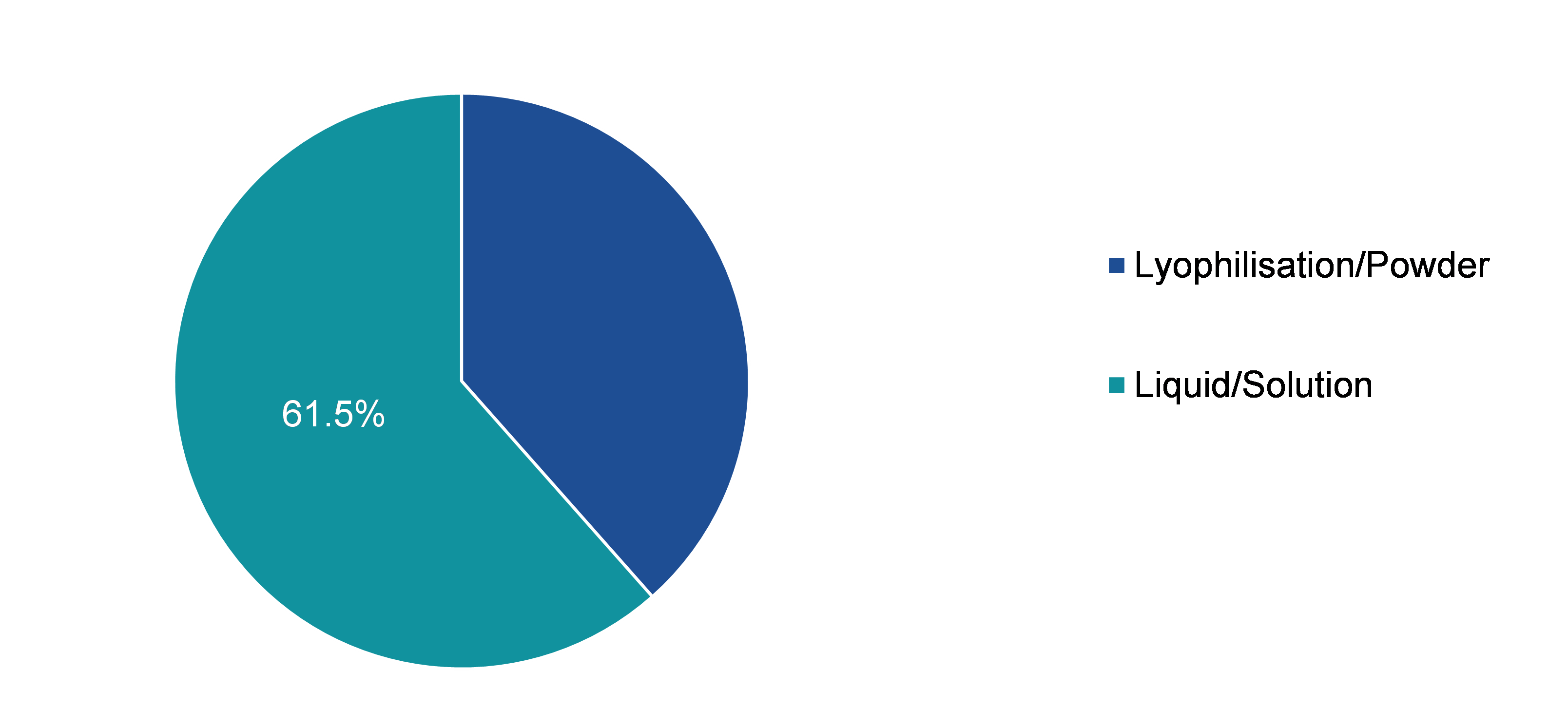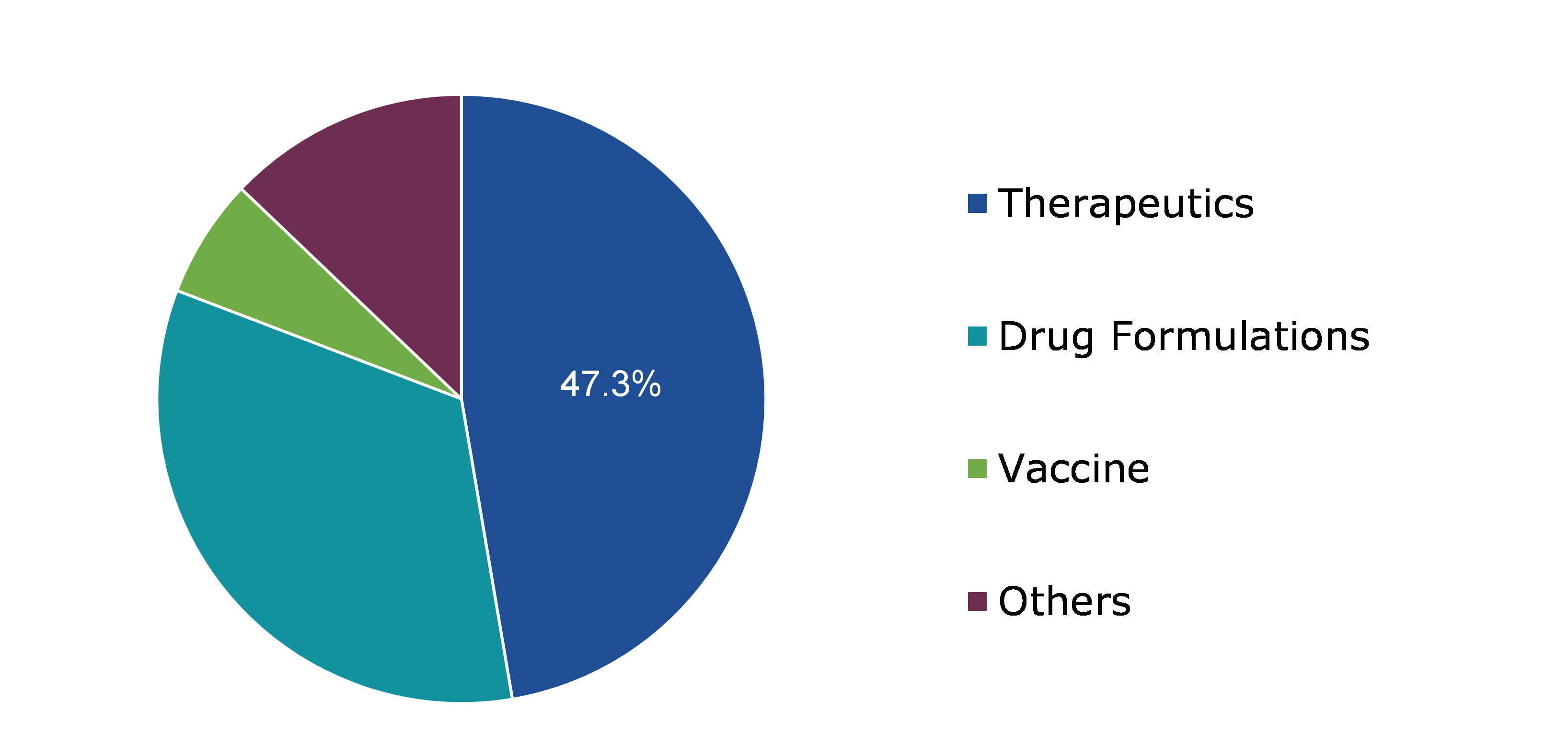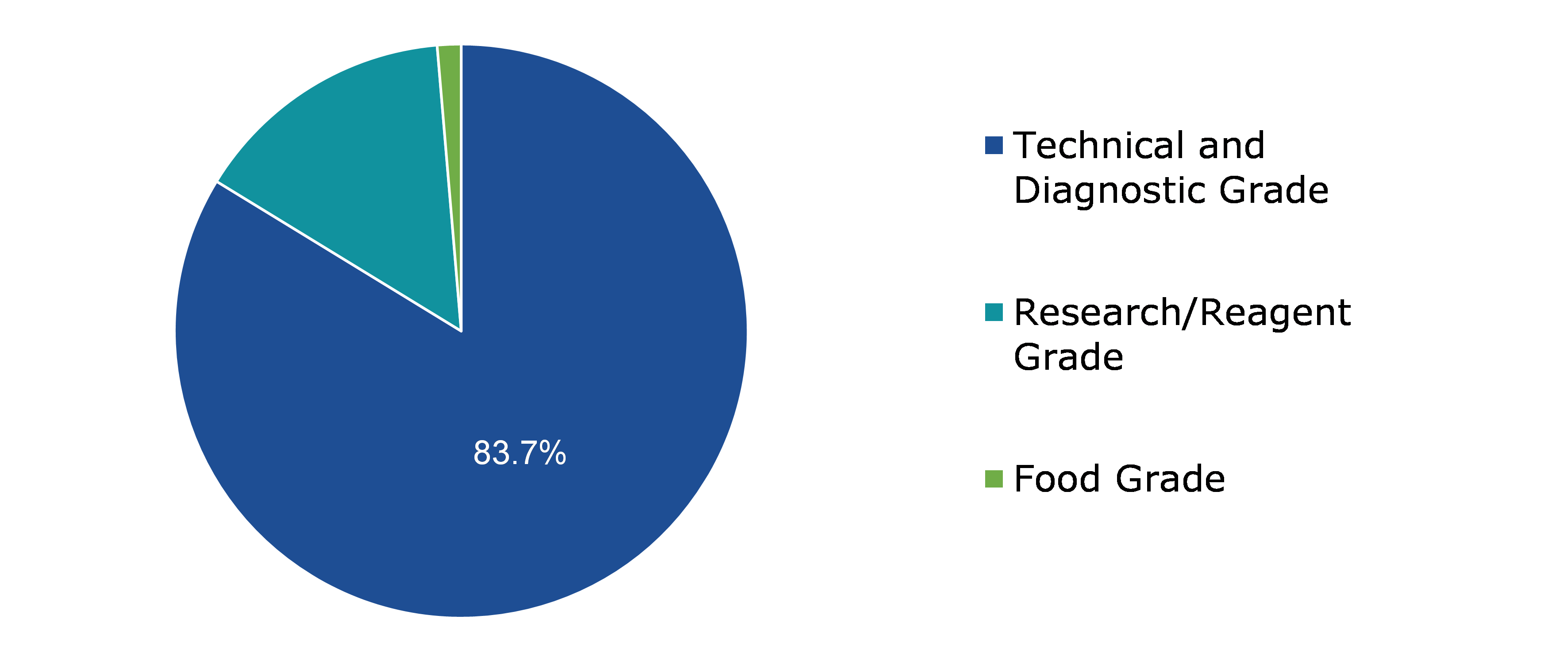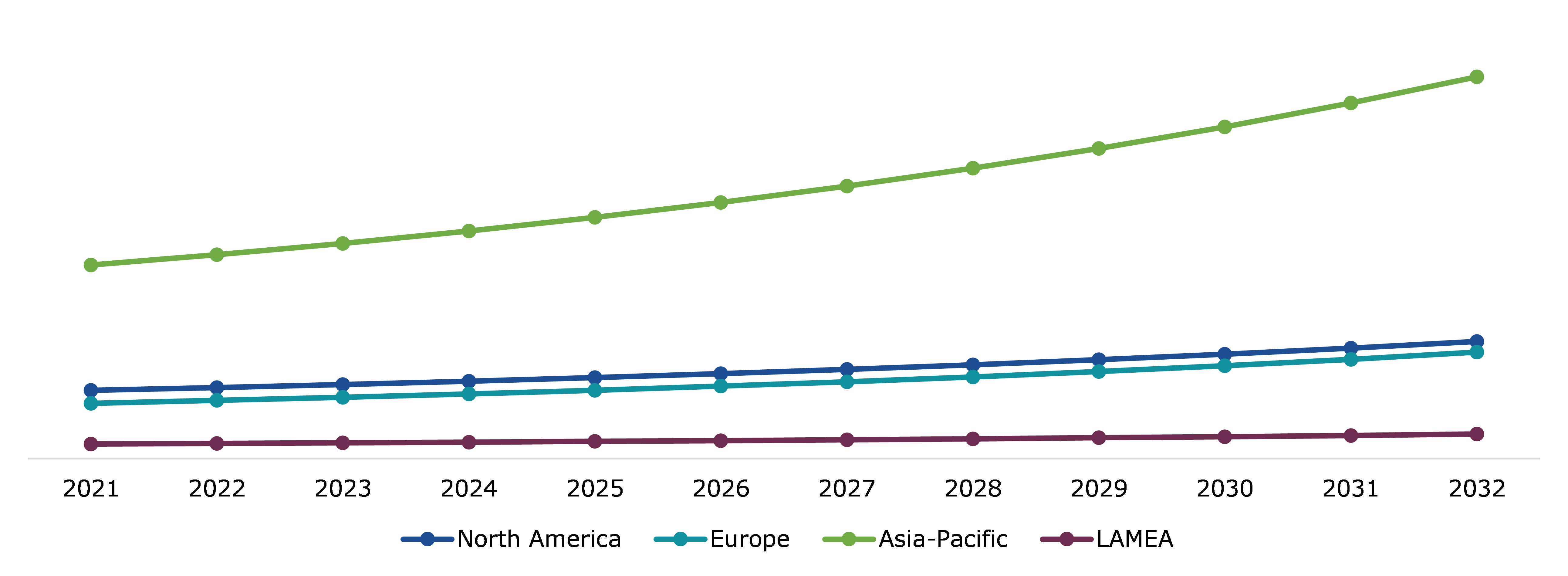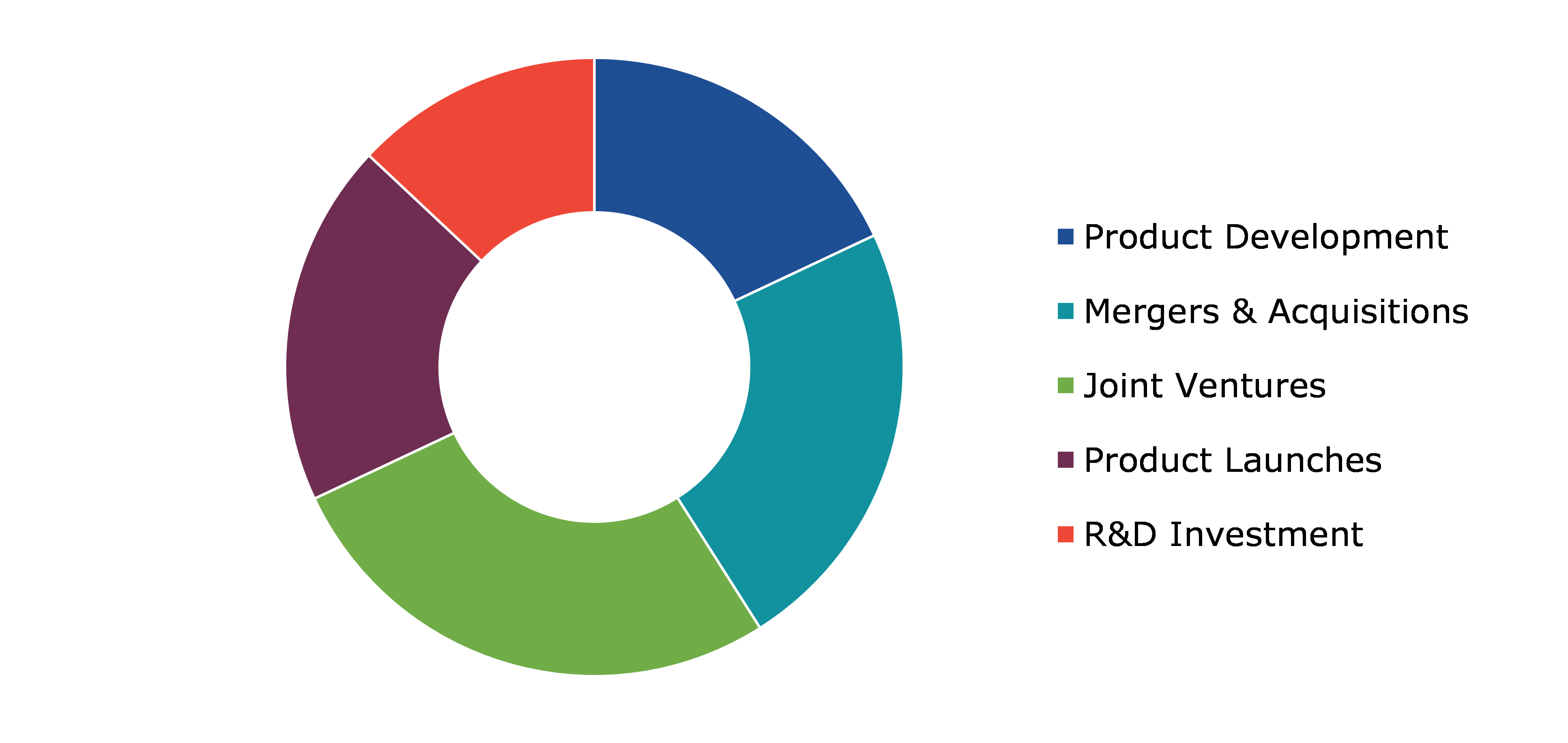Albumin Market Report
RA08582
Albumin Market by Type (Human Serum, Bovine Serum, and Recombinant HSA), Form (Lyophilisation/Powder and Liquid/Solution), Application (Therapeutics, Drug Formulations, Vaccine, and Others), Grade (Technical and Diagnostic Grade, Research/Reagent Grade, and Food Grade), and Regional Analysis (North America, Europe, Asia-Pacific, and LAMEA): Global Opportunity Analysis and Industry Forecast, 2022-2032
Global Albumin Market Analysis
The global albumin market size was $5,394.9 million in 2021 and is predicted to grow with a CAGR of 6.1%, by generating a revenue of $10,239.0 million by 2032.
Global Albumin Market Synopsis
The most prevalent protein in blood plasma is called albumin. When used therapeutically, it replaces lost fluids and aids in blood volume restoration following injuries, burns, operations, infections, and liver illnesses. Albumin has various properties such as it is non-toxic, non-immunogenic, biocompatible, and biodegradable and has a lengthy half-life of roughly 19 days, which makes it a good choice for drug delivery to different parts of the body. All such applications of albumin are anticipated to boost the albumin market growth in the upcoming years.
The high cost of albumin is likely to restrain the market growth in the forecast period. Extracting and purifying albumin requires expensive techniques and skilled labor. Due to this not many patients across the globe can afford such high treatment costs. This factor is projected to impede market growth in the future.
The increasing R&D efforts in drug or vaccine development are also anticipated to have a positive impact on the albumin market. For instance, the study ‘Albumin Administration is Efficacious in the Management of Patients with Cirrhosis: A Systematic Review of the Literature’ published in May 2020, claimed that albumin is safe and effective for treating or preventing a variety of complications arising from cirrhosis, such as ascites, paracentesis-induced circulatory dysfunction, infections, and hepatorenal syndrome, thus creating opportunities in the market and increasing demand for albumin.
According to regional analysis, the Asia-Pacific albumin market size accounted for $3,145.2 million in 2021 and is predicted to grow with a CAGR of 6.47% in the projected timeframe. The fast-growing healthcare infrastructure in the Asia-Pacific region and the population's rising disposable income are factors expected to drive regional expansion.
Albumin Overview
Albumin is a simple form of protein that is soluble in water and coagulable by heat, such as that is found in egg white, milk, and (in particular) blood serum. The group of globular proteins is known as albumin. All albumin families are moderately soluble in salt solutions, water-soluble, and denaturant when heated. Serum albumin is the albumin family member that is most frequently found in the blood. Blood plasma is the most prevalent location for albumins, which can be distinguished from blood proteins by their lack of glycosylation. Albuminoids are substances that contain albumin. 50% of the protein in human plasma comes from human serum albumin. Water, cations, fatty acids, hormones, bilirubin, thyroxin, and pharmaceuticals such as barbiturates are among the substances it binds with.
COVID-19 Impact on Global Albumin Market
During the COVID-19 pandemic period, the albumin market analysis saw a favorable market share increase. The mortality rate has increased since the emergence of the coronavirus outbreak and the incidence of patients who exhibit fatal signs including respiratory illnesses. The need for an efficient medicine or vaccine has also increased significantly as a result of the high infection rate and rising patient complications. Researchers and scientists have concentrated on making medications and vaccines using albumin due to the significant demand for powerful drugs to treat COVID-19.
The COVID-19 epidemic positively impacted the global albumin market and is projected to drive market expansion. The use of albumin has increased due to the development of vaccinations such as Covishield and Covaxin. For instance, approximately 10 planned and ongoing trials including albumin are being used to produce vaccines against COVID-19, according to the National Clinical Trial Registry. Thus, as vaccine production has increased, so has albumin’s usage, which is expected to fuel the albumin market throughout the projected period.
Increasing Prevalence of Chronic Diseases and Extensive Use of Albumin for Treatment Purpose to Drive the Market Growth
The middle-class population is increasing, and as urbanization picks up speed, people are becoming increasingly sedentary. Due to this, more people are becoming obese and developing ailments such as diabetes and liver disease. For instance, according to the survey conducted by World Health Organization, in 2020, it was estimated that the prevalence of chronic diseases in people, across the globe, is expected to increase by 57% compared to the last few years. Healthcare professionals are now widely using albumin for treating various chronic diseases. For instance, according to a research paper, ‘Albumin: Indications in chronic liver disease’ in 2022, albumin is largely employed as a plasma expander for the prevention and treatment of specific complications of cirrhosis with ascites and the diagnosis and treatment of acute kidney injury and hepatorenal syndrome. All these factors are estimated to accelerate the albumin market growth rate in the next few years.
To know more about global albumin market drivers, get in touch with our analysts here.
Strict Government Regulations in Developing Countries to Restrict the Use of Albumin Therapeutic Products
Despite the rising rates of hypoalbuminemia and hypovolemia around the world, the use of albumin is being constrained by factors including strict government regulations and a lack of therapeutic products. Stringent government regulations imposed on the manufacturing of medicinal applications are one of the main factors limiting the market growth. For instance, the U.S. Government makes sure that the plasma that is gathered and delivered, satisfies all applicable international quality, safety, and potency criteria. The current issue in the market is the lack of therapeutic medications for the treatment of certain illnesses. Furthermore, the high price of albumin is predicted to impede market expansion within the anticipated time frame. Albumin must be extracted and purified using advanced techniques and expert labor. As a result, only a few individuals in developing nations can pay for such expensive medical care. Future market growth is projected to be hampered by these problems.
Benefits of Human Serum Albumin to Provide Market Participants with Lucrative Opportunities
Albumin is easier to handle and store than normal globular proteins because of its stability. Albumin is a prime candidate to be employed as a surfactant to stop protein aggregation due to its surface-active properties. It is also very amphiphilic and has a high glass transition temperature, making it the perfect excipient for cryoprotection. Due to the various properties of albumin, major companies are focusing on developing their product portfolio and launching new products. The launch of new products by major players is stimulating the global market. For instance, ALBUMINEX 5 percent and ALBUMINEX 25 percent were introduced by Bio Products Laboratory (BPL) in May 2020, for the treatment of hypovolemia, ascites, hypoalbuminemia, including that resulting from burns, acute nephrosis, Acute Respiratory Distress Syndrome (ARDS), and cardiopulmonary bypass. These factors are predicted to boost the albumin market opportunity.
To know more about global albumin market opportunities, get in touch with our analysts here.
Global Albumin Market Share, by Type
Based on type, the market has been divided into human serum, bovine serum, and recombinant HSA. Among these, the human serum sub-segment is projected to generate the maximum revenue, and the recombinant HAS sub-segment is predicted to show the fastest growth.
Global Albumin Market Size, by Type, 2021
Source: Research Dive Analysis
The human serum sub-segment is anticipated to have a dominant market share and generate a revenue of $9,432.9 million by 2032, growing from $4,964.1 million in 2021. One of the proteins that are most prevalent in human plasma is Human Serum Albumin (HSA). The liver produces a protein called HSA that is essential for sustaining the plasma colloid oncotic pressure. The increasing usage of human serum albumin in cell culture procedures is predicted to be the cause of this development. For in vitro cell culture, cell culture is a common procedure at academic institutions and research labs. Additionally, increasing donation centers and rising public awareness regarding the value of blood donations and the need for albumin in medicine formulation are factors projected to support the albumin market share growth throughout the course of the projection year.
The recombinant HSA sub-segment is anticipated to show the fastest growth and generate a revenue of $356.2 million by 2032, increasing from $133.9 million in 2021. Recombinant Human Serum Albumin (rHSA) can coat surfaces, preventing vaccines from adhering to them unintentionally during vaccine production, formulation, and storage. Additionally, it shields vaccinations from aggregate and particle formation in recombinant HSA. Since rHSA is made from plants, there is no risk of bacterial and virus contamination. Furthermore, rHSA's superior consistency saves time and provides high-caliber performance. In order to promote cell growth and increase the production of recombinant proteins, rHSA is added to cell culture conditions. When protein contaminants are undesirable, such as in electrophoresis, rHSA is a good choice. rHSA is utilized in Western blots and ELISA applications as a blocking agent. Compared to plasma-derived HSA, rHSA is more homogeneous. It provides a distinctive and homogenous medium and is devoid of immunogenicity and toxicity.
Global Albumin Market Trends, by Form
Based on the form, the market is divided into lyophilization/powder and liquid/solution. Among these, the liquid/solution sub-segment accounted for the highest revenue share in 2021.
Global Albumin Market Forecast, by Form, 2021
Source: Research Dive Analysis
The liquid/solution sub-segment is anticipated to have a dominant market share and generate a revenue of $6,112.3 million by 2032, growing from $3,319.4 million in 2021. Plasma contains the protein albumin, which is produced by the liver (the clear liquid portion of your blood). To manufacture pharmaceutical albumin, proteins from human blood plasma are utilized. This medication functions by boosting plasma volume or albumin levels in the blood. Albumin makes up more than 50% of the protein in plasma and accounts for 10% of the liver's activity in protein synthesis. These factors are anticipated to boost the growth of the liquid/solution sub-segment during the analysis timeframe.
Global Albumin Market Value, by Application
Based on the application, the market is divided into therapeutics, drug formulation, vaccine, and others. Among these, the therapeutics sub-segment accounted for the highest revenue share in 2021.
Global Albumin Market Growth, by Application, 2021
Source: Research Dive Analysis
The therapeutics sub-segment is anticipated to have a dominant market share and generate a revenue of $4,685.9 million by 2032, growing from $2,553.0 million in 2021. Therapeutics are medical techniques used to control or treat certain disorders. A few examples of therapeutics are drug therapy, medical technology, nutrition therapy, and stem cell treatments. When a patient has an active disease, therapeutics can be employed as palliative care, preventive medicine, or to treat the disease itself or its symptoms. The increased usage of albumin to treat a variety of illnesses such as liver problems and blood loss is largely responsible for the therapeutics sub-segment growth. Additionally, albumin is frequently used to increase blood volume, which allows for the treatment of blood diseases. These factors are projected to fuel market expansion in the upcoming years.
Global Albumin Market Size, by Grade
Based on the grade, the market is divided into technical and diagnostic grade, research/reagent grade, and food grade. Among these, the technical and diagnostic grade sub-segment accounted for the highest revenue share in 2021.
Global Albumin Market Share, by Grade, 2021
Source: Research Dive Analysis
The technical and diagnostic grade sub-segment is anticipated to have a dominant market share and generate a revenue of $8,502.1 million by 2031, growing from $4,517.4 million in 2021. The technical & diagnostic grade of albumin is primarily used in biotechnology applications such as a blocking agent. The majority of the goods in this grade are utilized in cell culture applications. This diagnostic grade albumin is made to reduce the number of background-interfering analytes. The preparation process of albumin, such as cold ethanol fractionation versus heat shock isolation, has a significant impact on the albumin properties. Technical and diagnostic standard grade is indicated to meet the criteria of diverse applications for several biotechnology applications, including immunodetection.
Global Albumin Market Trends, Regional Insights
The albumin market was investigated across North America, Europe, Asia-Pacific, and LAMEA.
Global Albumin Market Size & Forecast, by Region, 2021-2032 (USD Million)
Source: Research Dive Analysis
The Market for Albumin in Asia-Pacific to be the Most Dominant
The Asia-Pacific albumin market share accounted for $3,145.2 million in 2021 and is projected to grow with a CAGR of 6.47%. The Asia-Pacific region's rapidly expanding healthcare infrastructure and rising disposable income of the population are both responsible for the regional expansion. People in underdeveloped nations can now afford to use expensive healthcare facilities as a result. Additionally, it is projected that rising incidences of blood-related conditions in humans, such as blood infections, projected to drive the albumin market demand in the coming years.
The global increase in blood fractionation and increasing demand for human albumin in Asia-Pacific are factors driving the manufacturing of human albumin. The albumin market is characterized by improvements in the utilization of human albumin protein as an automobile for the delivery of medications and lengthening the shelf life of pharmaceuticals and biologicals. As a plasma expander or as a method of replacement treatment, human albumin has been used extensively in therapeutic settings in the region.
Competitive Scenario in the Global Albumin Market
Investment and agreement are common strategies followed by major market players. For instance, in March 2021, a distribution agreement was made between Albumedix Ltd., a company that offers cutting-edge medicines and a global leader in recombinant human albumin (rHA), and FUJIFILM Wako Pure Chemical Corporation, a reputable and long-standing supplier of reagents.
Source: Research Dive Analysis
Some of the leading albumin market players are Baxter International Inc., China Biologic Products Holdings, Inc., CSL Limited, Grifols, S.A., Merck KGaA, Novozymes, Octapharma AG, Takeda Pharmaceuticals Company Limited, Thermo Fisher Scientific, and Ventria Bioscience Inc.
| Aspect | Particulars |
| Historical Market Estimations | 2020 |
| Base Year for Market Estimation | 2021 |
| Forecast Timeline for Market Projection | 2022-2032 |
| Geographical Scope | North America, Europe, Asia-Pacific, and LAMEA |
| Segmentation by Type |
|
| Segmentation by Form |
|
| Segmentation by Application |
|
| Segmentation by Grade |
|
| Key Companies Profiled |
|
Q1. What is the size of the albumin market?
A. The global albumin market was valued at $4,157.2 million in 2020, and is projected to reach $8,129.1 million by 2028, registering a CAGR of 10.1%.
Q2. Which are the major companies in the market?
A. Octapharma AG and Grifols are some of the prominent companies in the market.
Q3. Which region, among others, possesses greater investment opportunities in the near future?
A. The Asia- Pacific region possesses great investment opportunities for investors to witness the most promising growth in the future.
Q4. What will be the growth rate of the Asia- Pacific albumin market?
A. The share of Asia-Pacific market is anticipated to grow at a CAGR of 10.3%.
Q5. What are the strategies opted by the leading players in this market?
A. Agreement and investment are the two key strategies opted for by the operating companies in this market.
Q6. Which companies are investing more in R&D practices?
A. CSL Limited, Baxter International Inc., and Takeda Pharmaceuticals Company Limited are the companies investing more in R&D activities for developing new products and technologies.
1.Research Methodology
1.1.Desk Research
1.2.Real time insights and validation
1.3.Forecast model
1.4.Assumptions and forecast parameters
1.5.Market size estimation
1.5.1.Top-down approach
1.5.2.Bottom-up approach
2.Report Scope
2.1.Market definition
2.2.Key objectives of the study
2.3.Report overview
2.4.Market segmentation
2.5.Overview of the impact of COVID-19 on Global albumin market
3.Executive Summary
4.Market Overview
4.1.Introduction
4.2.Growth impact forces
4.2.1.Drivers
4.2.2.Restraints
4.2.3.Opportunities
4.3.Market value chain analysis
4.3.1.List of raw material suppliers
4.3.2.List of manufacturers
4.3.3.List of distributors
4.4.Innovation & sustainability matrices
4.4.1.Technology matrix
4.4.2.Regulatory matrix
4.5.Porter’s five forces analysis
4.5.1.Bargaining power of suppliers
4.5.2.Bargaining power of consumers
4.5.3.Threat of substitutes
4.5.4.Threat of new entrants
4.5.5.Competitive rivalry intensity
4.6.PESTLE analysis
4.6.1.Political
4.6.2.Economical
4.6.3.Social
4.6.4.Technological
4.6.5.Environmental
4.7.Impact of COVID-19 on albumin market
4.7.1.Pre-covid market scenario
4.7.2.Post-covid market scenario
5.Albumin Market Analysis, by Type
5.1.Overview
5.2.Human Serum
5.2.1.Definition, key trends, growth factors, and opportunities
5.2.2.Market size analysis, by region, 2021-2032
5.2.3.Market share analysis, by country, 2021-2032
5.3.Bovine Serum
5.3.1.Definition, key trends, growth factors, and opportunities
5.3.2.Market size analysis, by region, 2021-2032
5.3.3.Market share analysis, by country, 2021-2032
5.4.Recombinant HSA
5.4.1.Definition, key trends, growth factors, and opportunities
5.4.2.Market size analysis, by region, 2021-2032
5.4.3.Market share analysis, by country, 2021-2032
5.5.Research Dive Exclusive Insights
5.5.1.Market attractiveness
5.5.2.Competition heatmap
6.Albumin Market Analysis, by Form
6.1.Lyophilisation/Powder
6.1.1.Definition, key trends, growth factors, and opportunities
6.1.2.Market size analysis, by region, 2021-2032
6.1.3.Market share analysis, by country, 2021-2032
6.2.Liquid/Solution
6.2.1.Definition, key trends, growth factors, and opportunities
6.2.2.Market size analysis, by region, 2021-2032
6.2.3.Market share analysis, by country, 2021-2032
6.3.Research Dive Exclusive Insights
6.3.1.Market attractiveness
6.3.2.Competition heatmap
7.Albumin Market Analysis, by Application
7.1.Therapeutics
7.1.1.Definition, key trends, growth factors, and opportunities
7.1.2.Market size analysis, by region, 2021-2032
7.1.3.Market share analysis, by country, 2021-2032
7.2.Drug Formulations
7.2.1.Definition, key trends, growth factors, and opportunities
7.2.2.Market size analysis, by region, 2021-2032
7.2.3.Market share analysis, by country, 2021-2032
7.3.Vaccine
7.3.1.Definition, key trends, growth factors, and opportunities
7.3.2.Market size analysis, by region, 2021-2032
7.3.3.Market share analysis, by country, 2021-2032
7.4.Others
7.4.1.Definition, key trends, growth factors, and opportunities
7.4.2.Market size analysis, by region, 2021-2032
7.4.3.Market share analysis, by country, 2021-2032
7.5.Research Dive Exclusive Insights
7.5.1.Market attractiveness
7.5.2.Competition heatmap
8.Albumin Market Analysis, by Grade
8.1.Technical and Diagnostic Grade
8.1.1.Definition, key trends, growth factors, and opportunities
8.1.2.Market size analysis, by region, 2021-2032
8.1.3.Market share analysis, by country, 2021-2032
8.2. Research/Reagent Grade
8.2.1.Definition, key trends, growth factors, and opportunities
8.2.2.Market size analysis, by region, 2021-2032
8.2.3.Market share analysis, by country, 2021-2032
8.3.Food Grade
8.3.1.Definition, key trends, growth factors, and opportunities
8.3.2.Market size analysis, by region, 2021-2032
8.3.3.Market share analysis, by country, 2021-2032
8.4.Research Dive Exclusive Insights
8.4.1.Market attractiveness
8.4.2.Competition heatmap
9.Albumin Market, by Region
9.1.North America
9.1.1.U.S.
9.1.1.1.Market size analysis, by Type, 2021-2032
9.1.1.2.Market size analysis, by Form, 2021-2032
9.1.1.3.Market size analysis, by Application, 2021-2032
9.1.1.4.Market size analysis, by Grade, 2021-2032
9.1.2.Canada
9.1.2.1.Market size analysis, by Type, 2021-2032
9.1.2.2.Market size analysis, by Form, 2021-2032
9.1.2.3.Market size analysis, by Application, 2021-2032
9.1.2.4.Market size analysis, by Grade, 2021-2032
9.1.3.Mexico
9.1.3.1.Market size analysis, by Type, 2021-2032
9.1.3.2.Market size analysis, by Form, 2021-2032
9.1.3.3.Market size analysis, by Application, 2021-2032
9.1.3.4.Market size analysis, by Grade, 2021-2032
9.1.4.Research Dive Exclusive Insights
9.1.4.1.Market attractiveness
9.1.4.2.Competition heatmap
9.2.Europe
9.2.1.Germany
9.2.1.1.Market size analysis, by Type, 2021-2032
9.2.1.2.Market size analysis, by Form, 2021-2032
9.2.1.3.Market size analysis, by Application, 2021-2032
9.2.1.4.Market size analysis, by Grade, 2021-2032
9.2.2.UK
9.2.2.1.Market size analysis, by Type, 2021-2032
9.2.2.2.Market size analysis, by Form, 2021-2032
9.2.2.3.Market size analysis, by Application, 2021-2032
9.2.2.4.Market size analysis, by Grade, 2021-2032
9.2.3.France
9.2.3.1.Market size analysis, by Type, 2021-2032
9.2.3.2.Market size analysis, by Form, 2021-2032
9.2.3.3.Market size analysis, by Application, 2021-2032
9.2.3.4.Market size analysis, by Grade, 2021-2032
9.2.4.Spain
9.2.4.1.Market size analysis, by Type, 2021-2032
9.2.4.2.Market size analysis, by Form, 2021-2032
9.2.4.3.Market size analysis, by Application, 2021-2032
9.2.4.4.Market size analysis, by Grade, 2021-2032
9.2.5.Italy
9.2.5.1.Market size analysis, by Type, 2021-2032
9.2.5.2.Market size analysis, by Form, 2021-2032
9.2.5.3.Market size analysis, by Application, 2021-2032
9.2.5.4.Market size analysis, by Grade, 2021-2032
9.2.6.Rest of Europe
9.2.6.1.Market size analysis, by Type, 2021-2032
9.2.6.2.Market size analysis, by Form, 2021-2032
9.2.6.3.Market size analysis, by Application, 2021-2032
9.2.6.4.Market size analysis, by Grade, 2021-2032
9.2.7.Research Dive Exclusive Insights
9.2.7.1.Market attractiveness
9.2.7.2.Competition heatmap
9.3.Asia-Pacific
9.3.1.China
9.3.1.1.Market size analysis, by Type, 2021-2032
9.3.1.2.Market size analysis, by Form, 2021-2032
9.3.1.3.Market size analysis, by Application, 2021-2032
9.3.1.4.Market size analysis, by Grade, 2021-2032
9.3.2.Japan
9.3.2.1.Market size analysis, by Type, 2021-2032
9.3.2.2.Market size analysis, by Form, 2021-2032
9.3.2.3.Market size analysis, by Application, 2021-2032
9.3.2.4.Market size analysis, by Grade, 2021-2032
9.3.3.India
9.3.3.1.Market size analysis, by Type, 2021-2032
9.3.3.2.Market size analysis, by Form, 2021-2032
9.3.3.3.Market size analysis, by Application, 2021-2032
9.3.3.4.Market size analysis, by Grade, 2021-2032
9.3.4.Australia
9.3.4.1.Market size analysis, by Type, 2021-2032
9.3.4.2.Market size analysis, by Form, 2021-2032
9.3.4.3.Market size analysis, by Application, 2021-2032
9.3.4.4.Market size analysis, by Grade, 2021-2032
9.3.5.South Korea
9.3.5.1.Market size analysis, by Type, 2021-2032
9.3.5.2.Market size analysis, by Form, 2021-2032
9.3.5.3.Market size analysis, by Application, 2021-2032
9.3.5.4.Market size analysis, by Grade, 2021-2032
9.3.6.Rest of Asia-Pacific
9.3.6.1.Market size analysis, by Type, 2021-2032
9.3.6.2.Market size analysis, by Form, 2021-2032
9.3.6.3.Market size analysis, by Application, 2021-2032
9.3.6.4.Market size analysis, by Grade, 2021-2032
9.3.7.Research Dive Exclusive Insights
9.3.7.1.Market attractiveness
9.3.7.2.Competition heatmap
9.4.LAMEA
9.4.1.Brazil
9.4.1.1.Market size analysis, by Type, 2021-2032
9.4.1.2.Market size analysis, by Form, 2021-2032
9.4.1.3.Market size analysis, by Application, 2021-2032
9.4.1.4.Market size analysis, by Grade, 2021-2032
9.4.2.Saudi Arabia
9.4.2.1.Market size analysis, by Type, 2021-2032
9.4.2.2.Market size analysis, by Form, 2021-2032
9.4.2.3.Market size analysis, by Application, 2021-2032
9.4.2.4.Market size analysis, by Grade, 2021-2032
9.4.3.UAE
9.4.3.1.Market size analysis, by Type, 2021-2032
9.4.3.2.Market size analysis, by Form, 2021-2032
9.4.3.3.Market size analysis, by Application, 2021-2032
9.4.3.4.Market size analysis, by Grade, 2021-2032
9.4.4.South Africa
9.4.4.1.Market size analysis, by Type, 2021-2032
9.4.4.2.Market size analysis, by Form, 2021-2032
9.4.4.3.Market size analysis, by Application, 2021-2032
9.4.4.4.Market size analysis, by Grade, 2021-2032
9.4.5.Rest of LAMEA
9.4.5.1.Market size analysis, by Type, 2021-2032
9.4.5.2.Market size analysis, by Form, 2021-2032
9.4.5.3.Market size analysis, by Application, 2021-2032
9.4.5.4.Market size analysis, by Grade, 2021-2032
9.4.6.Research Dive Exclusive Insights
9.4.6.1.Market attractiveness
9.4.6.2.Competition heatmap
10.Competitive Landscape
10.1.Top winning strategies, 2021
10.1.1.By strategy
10.1.2.By year
10.2.Strategic overview
10.3.Market share analysis, 2021
11.Company Profiles
11.1.Baxter International Inc.
11.1.1.Overview
11.1.2.Business segments
11.1.3.Product portfolio
11.1.4.Financial performance
11.1.5.Recent developments
11.1.6.SWOT analysis
11.2.China Biologic Products Holdings, Inc.
11.2.1.Overview
11.2.2.Business segments
11.2.3.Product portfolio
11.2.4.Financial performance
11.2.5.Recent developments
11.2.6.SWOT analysis
11.3.CSL Limited
11.3.1.Overview
11.3.2.Business segments
11.3.3.Product portfolio
11.3.4.Financial performance
11.3.5.Recent developments
11.3.6.SWOT analysis
11.4.Grifols, S.A.
11.4.1.Overview
11.4.2.Business segments
11.4.3.Product portfolio
11.4.4.Financial performance
11.4.5.Recent developments
11.4.6.SWOT analysis
11.5.Merck KGaA
11.5.1.Overview
11.5.2.Business segments
11.5.3.Product portfolio
11.5.4.Financial performance
11.5.5.Recent developments
11.5.6.SWOT analysis
11.6.Novozymes
11.6.1.Overview
11.6.2.Business segments
11.6.3.Product portfolio
11.6.4.Financial performance
11.6.5.Recent developments
11.6.6.SWOT analysis
11.7. Octapharma AG
11.7.1.Overview
11.7.2.Business segments
11.7.3.Product portfolio
11.7.4.Financial performance
11.7.5.Recent developments
11.7.6.SWOT analysis
11.8.Takeda Pharmaceuticals Company Limited
11.8.1.Overview
11.8.2.Business segments
11.8.3.Product portfolio
11.8.4.Financial performance
11.8.5.Recent developments
11.8.6.SWOT analysis
11.9.Thermo Fisher Scientific
11.9.1.Overview
11.9.2.Business segments
11.9.3.Product portfolio
11.9.4.Financial performance
11.9.5.Recent developments
11.9.6.SWOT analysis
11.10.Ventria Bioscience Inc.
11.10.1.Overview
11.10.2.Business segments
11.10.3.Product portfolio
11.10.4.Financial performance
11.10.5.Recent developments
11.10.6.SWOT analysis
12.Appendix
12.1.Parent & peer market analysis
12.2.Premium insights from industry experts
12.3.Related reports
Albumin is the most abundant protein found in the human blood which is made by the liver and it constitutes around 50%-60% of all the protein in the blood. The main function of albumin is to keep the fluid in your bloodstream and prevent the leaking of fluid into other tissues. Moreover, it helps in carrying various important substances, such as hormones, vitamins, fatty acids, ions, and enzymes throughout your body. Low albumin levels in the blood can result in serious kidney or liver problems and elevated albumin levels can be a sign of dehydration, diarrhoea, or other serious conditions.
Future Analysis of the Global Albumin Market
With the growing prevalence of chronic diseases across the globe and the increasing research & development activities of using albumin in various therapeutic areas, the albumin market is expected to witness remarkable growth during the analysis period. Besides, the increasing diseases and serious health conditions among individuals, such as blood loss, or trauma, are expected to fortify the growth of the market over the estimated timeframe. Moreover, the increasing technological advancements in biotechnological industries and the introduction of albumin products by leading companies are expected to create expansive growth opportunities for companies during the forecast period. However, the expensive techniques and skilled labor to extract and purify albumin may hinder the growth of the market over the analysis period.
According to the report published by Research Dive, the global albumin market is anticipated to garner a revenue of $10,239.0 million and exponentially grow at a healthy CAGR of 6.1% during the forecast period from 2022 to 2032. The major players of the market include Baxter International Inc., China Biologic Products Holdings, Inc., CSL Limited, Grifols, S.A., Merck KGaA, Novozymes, Octapharma AG, Takeda Pharmaceuticals Company Limited, Thermo Fisher Scientific, and Ventria Bioscience Inc.
Albumin Market Trends and Developments
The key companies operating in the industry are adopting various growth strategies & business tactics, such as partnerships, collaborations, mergers & acquisitions, and launches to maintain a robust position in the overall market, which is subsequently helping the global albumin market to grow exponentially. For instance:
- In April 2020, CSL Limited, a leading Australian multinational specialty biotechnology company that develops innovative biotherapies and influenza vaccines, collaborated with Biotest, BPL Group, LFB, and Octapharma, the global plasma leaders. With this collaboration, the companies aimed to develop a potential plasma-derived therapy for treating Covid-19 affected patients globally.
- In September 2021, Baxter International Inc., a leading American multinational health care company, acquired Hillrom, a renowned American medical technology provider. With this acquisition, Baxter aimed to expand its product portfolio by innovating a wide array of medical products and services for patients and clinicians all across the globe.
- In November 2021, Grifols, a leading Spanish multinational pharmaceutical and chemical manufacturer that focuses on developing medicines derived from plasma, launched its latest product named “ALBUTEIN FlexBag”. This albumin-based product is designed for easy use, reducing bubble accumulation during infusion, and helping medical staff and nurses avoid needle sticks. Additionally, this product is equipped with a flexible container that permits simple storage and greater convenience.
Most Profitable Region
The Asia-Pacific region is expected to be most dominant by 2032 and is predicted to grow at a CAGR of 6.47% over the analysis timeframe. This is mainly due to the rapidly expanding healthcare infrastructure and increasing disposable income of people in the region. Besides, the growing prevalence of blood-related conditions in humans like blood infections is another factor expected to boost the Asia-Pacific albumin market growth in the coming years.
Covid-19 Impact on the Market
Though the outbreak of the Covid-19 pandemic has devastated several other industries, it has had a positive impact on the albumin market. Due to the increasing rate of infection cases and growing complications in the patients, the demand for effective drugs and vaccines increased rapidly. This led researchers and scientists to focus on developing drugs and vaccines by using albumin. All these factors have boosted the growth of the market during the period of crisis.
Personalize this research
- Triangulate with your own data
- Request your format and definition
- Get a deeper dive on a specific application, geography, customer or competitor
- + 1-888-961-4454 Toll - Free
- support@researchdive.com

